Updated on November 21st, 2022 by Bob Ciura
In the world of investing, volatility matters. Investors are reminded of this every time there is a downturn in the broader market and individual stocks that are more volatile than others experience enormous swings in price.
Volatility is a proxy for risk; more volatility generally means a riskier portfolio. The volatility of a security or portfolio against a benchmark is called Beta.
In short, Beta is measured via a formula that calculates the price risk of a security or portfolio against a benchmark, which is typically the broader market as measured by the S&P 500.
Here’s how to read stock betas:
- A beta of 1.0 means the stock moves equally with the S&P 500
- A beta of 2.0 means the stock moves twice as much as the S&P 500
- A beta of 0.0 means the stocks moves don’t correlate with the S&P 500
- A beta of -1.0 means the stock moves precisely opposite the S&P 500
Interestingly, low beta stocks have historically outperformed the market… But more on that later.
You can download a spreadsheet of the 100 lowest beta stocks (along with important financial metrics like price-to-earnings ratios and dividend yields) below:
This article will discuss beta more thoroughly, why low-beta stocks tend to outperform, and provide a discussion of the 5 lowest-beta dividend stocks in the Sure Analysis Research Database. The table of contents below allows for easy navigation.
Table of Contents
The Evidence for Low Beta Outperformance
Beta is helpful in understanding the overall price risk level for investors during market downturns in particular. The lower the Beta value, the less volatility the stock or portfolio should exhibit against the benchmark. This is beneficial for investors for obvious reasons, particularly those that are close to or already in retirement, as drawdowns should be relatively limited against the benchmark.
Importantly, low or high Beta simply measures the size of the moves a security makes; it does not mean necessarily that the price of the security stays nearly constant. Indeed, securities can be low Beta and still be caught in long-term downtrends, so this is simply one more tool investors can use when building a portfolio.
The conventional wisdom would suggest that lower Beta stocks should underperform the broader markets during uptrends and outperform during downtrends, offering investors lower prospective returns in exchange for lower risk.
However, history would suggest that simply isn’t the case. Indeed, this paper from Harvard Business School suggests that not only do low Beta stocks not underperform the broader market over time – including all market conditions – they actually outperform.
A long-term study wherein the stocks with the lowest 30% of Beta scores in the US were pitted against stocks with the highest 30% of Beta scores suggested that low Beta stocks outperform by several percentage points annually.
Over time, this sort of outperformance can mean the difference between a comfortable retirement and having to continue working. While low Beta stocks aren’t a panacea, the case for their outperformance over time – and with lower risk – is quite compelling.
How To Calculate Beta
The formula to calculate a security’s Beta is fairly straightforward. The result, expressed as a number, shows the security’s tendency to move with the benchmark.
For example, a Beta value of 1.0 means that the security in question should move in lockstep with the benchmark. A Beta of 2.0 means that moves in the security should be twice as large in magnitude as the benchmark and in the same direction, while a negative Beta means that movements in the security and benchmark tend to move in opposite directions or are negatively correlated.
Related: The S&P 500 Stocks With Negative Beta.
In other words, negatively correlated securities would be expected to rise when the overall market falls, or vice versa. A small value of Beta (something less than 1.0) indicates a stock that moves in the same direction as the benchmark, but with smaller relative changes.
Here’s a look at the formula:

The numerator is the covariance of the asset in question with the market, while the denominator is the variance of the market. These complicated-sounding variables aren’t actually that difficult to compute – especially in Excel.
Additionally, Beta can also be calculated as the correlation coefficient of the security in question and the market, multiplied by the security’s standard deviation divided by the market’s standard deviation.
Finally, there’s a greatly simplified way to calculate Beta by manipulating the capital asset pricing model formula (more on Beta and the capital asset pricing model later in this article).
Here’s an example of the data you’ll need to calculate Beta:
- Risk-free rate (typically Treasuries at least two years out)
- Your asset’s rate of return over some period (typically one year to five years)
- Your benchmark’s rate of return over the same period as the asset
To show how to use these variables to do the calculation of Beta, we’ll assume a risk-free rate of 2%, our stock’s rate of return of 7% and the benchmark’s rate of return of 8%.
You start by subtracting the risk-free rate of return from both the security in question and the benchmark. In this case, our asset’s rate of return net of the risk-free rate would be 5% (7% – 2%). The same calculation for the benchmark would yield 6% (8% – 2%).
These two numbers – 5% and 6%, respectively – are the numerator and denominator for the Beta formula. Five divided by six yields a value of 0.83, and that is the Beta for this hypothetical security. On average, we’d expect an asset with this Beta value to be 83% as volatile as the benchmark.
Thinking about it another way, this asset should be about 17% less volatile than the benchmark while still having its expected returns correlated in the same direction.
Beta & The Capital Asset Pricing Model (CAPM)
The Capital Asset Pricing Model, or CAPM, is a common investing formula that utilizes the Beta calculation to account for the time value of money as well as the risk-adjusted returns expected for a particular asset.
Beta is an essential component of the CAPM because without it, riskier securities would appear more favorable to prospective investors. Their risk wouldn’t be accounted for in the calculation.
The CAPM formula is as follows:

The variables are defined as:
- ERi = Expected return of investment
- Rf = Risk-free rate
- βi = Beta of the investment
- ERm = Expected return of market
The risk-free rate is the same as in the Beta formula, while the Beta that you’ve already calculated is simply placed into the CAPM formula. The expected return of the market (or benchmark) is placed into the parentheses with the market risk premium, which is also from the Beta formula. This is the expected benchmark’s return minus the risk-free rate.
To continue our example, here is how the CAPM actually works:
ER = 2% + 0.83(8% – 2%)
In this case, our security has an expected return of 6.98% against an expected benchmark return of 8%. That may be okay depending upon the investor’s goals as the security in question should experience less volatility than the market thanks to its Beta of less than 1. While the CAPM certainly isn’t perfect, it is relatively easy to calculate and gives investors a means of comparison between two investment alternatives.
Now, we’ll take a look at five stocks that not only offer investors low Beta scores, but attractive prospective returns as well.
Analysis On The 5 Lowest-Beta Dividend Stocks
The following 5 stocks have the lowest (but positive) Beta values, in ascending order from lowest to highest. They also pay dividends to shareholders. We focused on Betas above 0, as we are still looking for stocks that are positively correlated with the broader market:
5. Molson Coors (TAP)
Molson Coors Beverage Company, previously Molson Coors Brewing Company, was founded in 1873. Since then, it has grown into one of the largest U.S. brewers, with a variety of brands including Coors Light, Molson Canadian, Carling, Blue Moon, Hop Valley, Leinenkugel’s, Crispin Cider, and Miller Lite through a joint venture called MillerCoors.
The company has a significant presence outside the U.S. Its international markets include Canada, Europe, Latin America, Asia, and Africa. On February 23rd, 2022, the company announced a 12% increase to the quarterly dividend to $0.38 per share.
On November 1st, 2022, Molson Coors reported third quarter results for the period ending September 30th, 2022. For the quarter, the company generated net sales of $2.9 billion, a 4.0% increase compared to Q3 2021. Net sales were up 6.8% in North America, but down 6.4% in Europe, the Middle East and Africa, and Asia-Pacific.
Reported net income equaled $216 million or $0.99 per share compared to $453 million or $2.08 per share in Q3 2021. On an adjusted basis, earningsper-share equaled $1.32 versus $1.75 prior. The company repurchased 740,000 shares in the first nine months of 2022.
Molson Coors continues to expect net sales to increase by a mid-single digit rate for 2022, on a constant currency basis.
TAP has a Beta score of 0.52.
Click here to download our most recent Sure Analysis report on Molson Coors (preview of page 1 of 3 shown below):
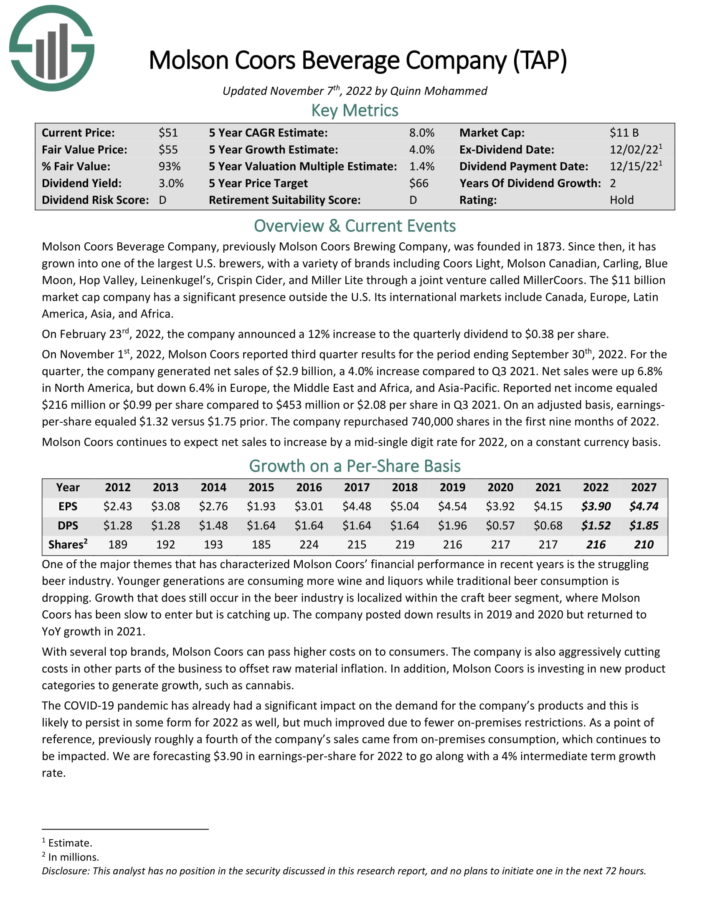
4. AT&T Inc. (T)
AT&T is a large telecommunications company serving over 100 million customers. The company generated $169 billion in revenue in 2021.
In April 2022, AT&T completed the spin-off of WarnerMedia to form the new company Warner Bros. Discovery (WBD). AT&T shareholders received 0.241917 shares of WBD for every 1 share of AT&T they held.
Related: Communication Services Stocks List | The 5 Best Now
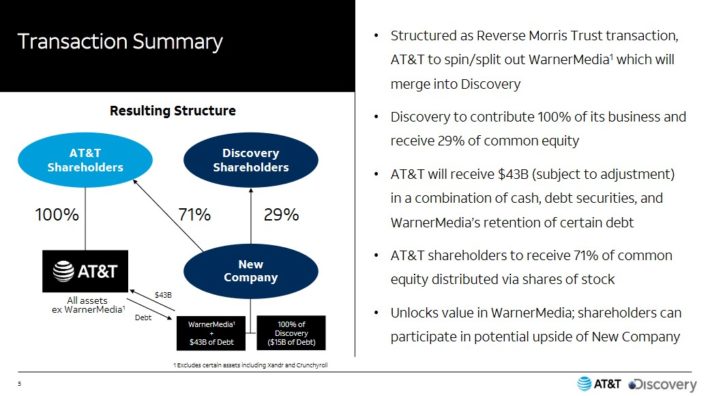
Source: Investor Presentation
In mid-October, AT&T reported (10/20/22) financial results for the third quarter of fiscal 2022. The company grew its revenue 3% over last year’s quarter thanks to strong customer additions across its growing 5G wireless and fiber networks. The company is investing in the expansion of its 5G and fiber networks at a record pace.
AT&T posted 338,000 fiber net additions and thus it has posted more than 200,000 additions per quarter for 11 consecutive quarters. It also posted 708,000 postpaid phone net additions. Moreover, it grew its wireless revenues by 5.6%, its best growth rate in more than a decade. Adjusted earnings-per-share grew 3%, from $0.66 to $0.68, and beat the analysts’ consensus by $0.07.
AT&T has a Beta score of 0.48.
Click here to download our most recent Sure Analysis report on AT&T (preview of page 1 of 3 shown below):
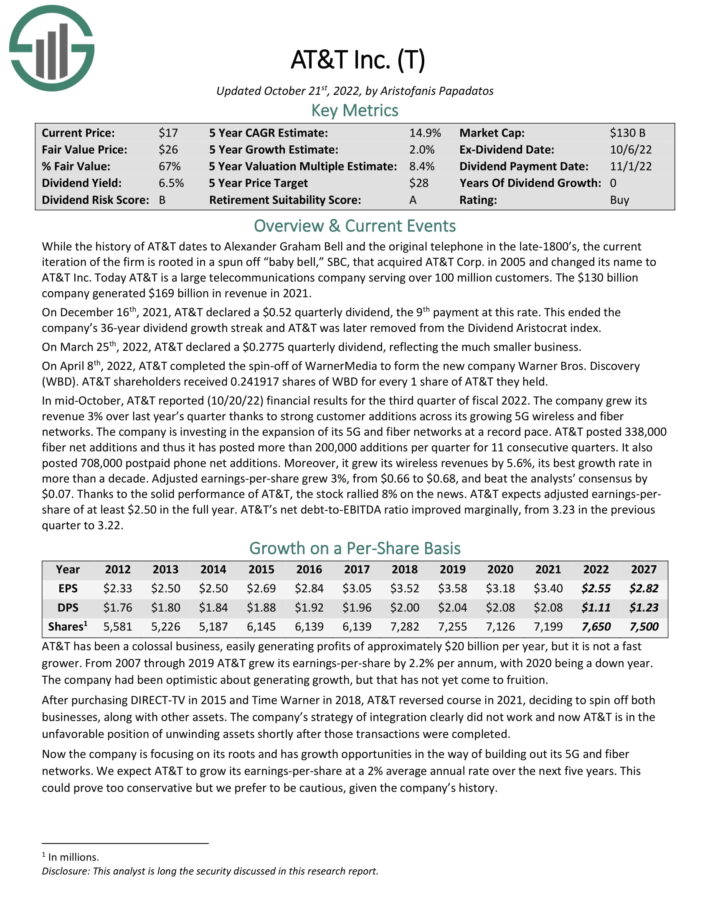
3. DaVita Inc. (DVA)
DaVita provides kidney dialysis services for patients suffering from chronic kidney failure or end stage renal disease. The company operates kidney dialysis centers and provides related lab services in outpatient dialysis centers. DaVita stock does not pay a dividend.
As a constituent of Berkshire Hathaway’s investment portfolio, DaVita is a Warren Buffett stock.
2. Pfizer Inc. (PFE)
Pfizer Inc. is a global pharmaceutical company that focuses on prescription drugs and vaccines. With a market capitalization above $200 billion, Pfizer is a mega-cap stock.
Pfizer’s new CEO completed a series of transactions significantly altering the company structure and strategy. Pfizer formed the GSK Consumer Healthcare Joint Venture in 2019 with GlaxoSmithKline plc (GSK), which includes Pfizer’s over-the-counter business. Pfizer owns 32% of the JV. Pfizer spun off its Upjohn segment and merged it with Mylan forming Viatris for its off patent, branded and generic medicines in 2020.
Pfizer’s top products are Eliquis, Ibrance, Prevnar, Enebrel (international), Sutent, Xtandi, Vyndaqel/ Vyndamax, Inlyta, Xeljanz, Plaxlovid, and Comiranty. Pfizer had revenue of $81.3B in 2021.
Pfizer reported Q3 2022 results on November 1st, 2022.
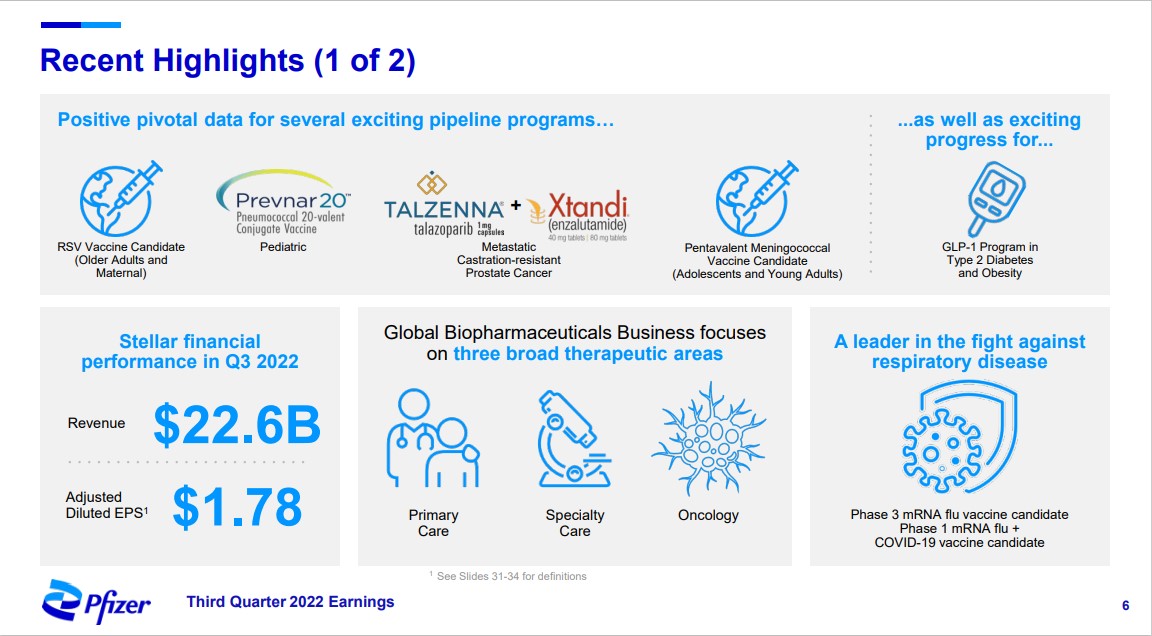
Source: Investor Presentation
Companywide revenue fell 6% and adjusted diluted earnings per share rose 40% to $1.78 versus $1.27 on a year-over-year basis. Diluted GAAP earnings per share rose 6% to $1.51 from $1.42 in comparable quarters.
PFE has a Beta score of 0.40.
Click here to download our most recent Sure Analysis report on Pfizer (preview of page 1 of 3 shown below):
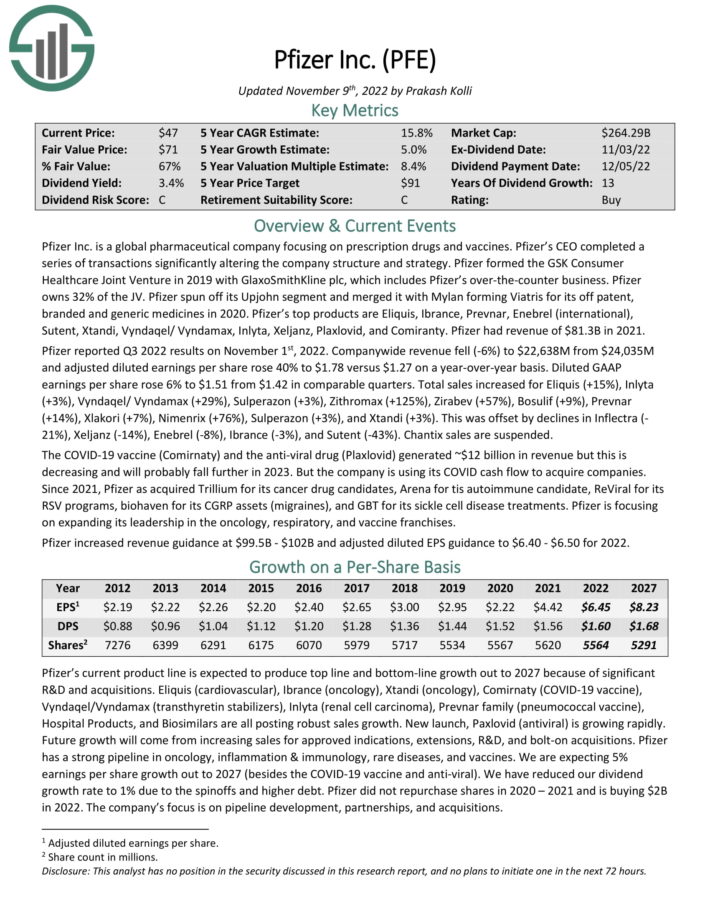
1. Verizon Communications (VZ)
Verizon Communications is one of the largest wireless carriers in the country. Wireless contributes three-quarters of all revenues, and broadband and cable services account for about a quarter of sales. The company’s network covers ~300 million people and 98% of the U.S.
On October 21st, 2022, Verizon announced third quarter earnings results for the period ending September 30th, 2022. Revenue grew 4% to $34.2 billion, which topped estimates by $410 million. Adjusted earnings-per-share of $1.32 compared unfavorably to $1.41 in the prior year, but was $0.03 better than expected.
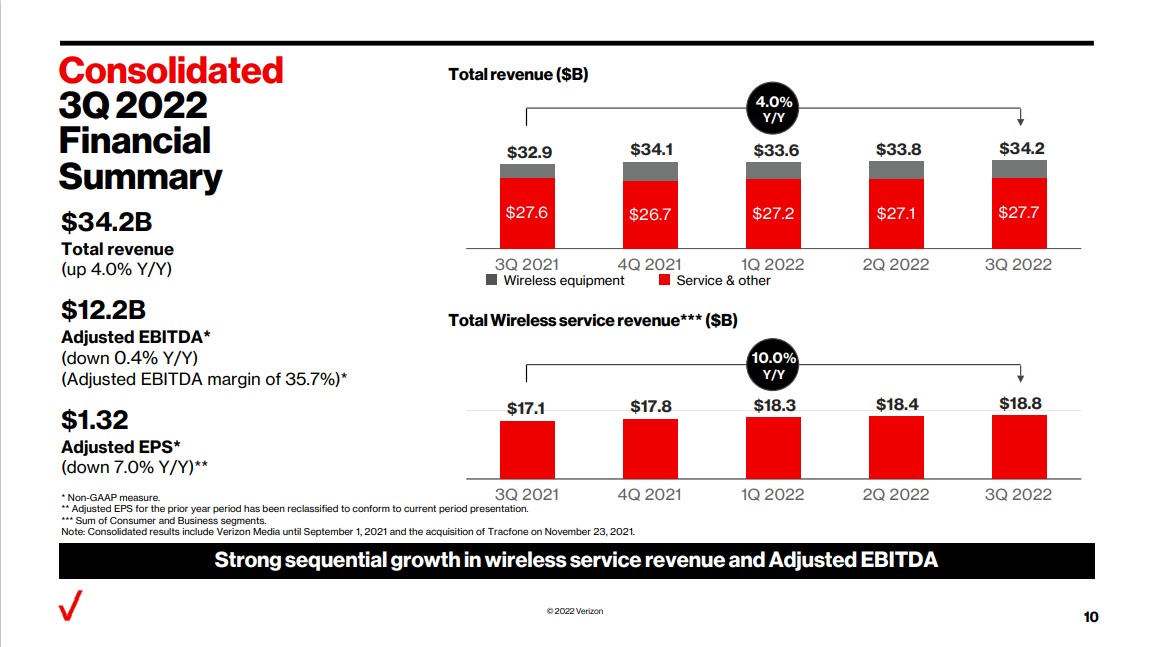
Source: Investor Presentation
Verizon added just 8,000 net new postpaid phone customers during the quarter. Revenue for the Consumer segment grew 10.8% to $25.8 billion, again driven higher equipment sales and a 10% increase in wireless revenue growth. Average revenue per account increased 3.8%. Broadband had 377K net additions during the quarter, which included 342K fixed wireless net additions.
VZ has a Beta score of 0.34.
Click here to download our most recent Sure Analysis report on VZ (preview of page 1 of 3 shown below):
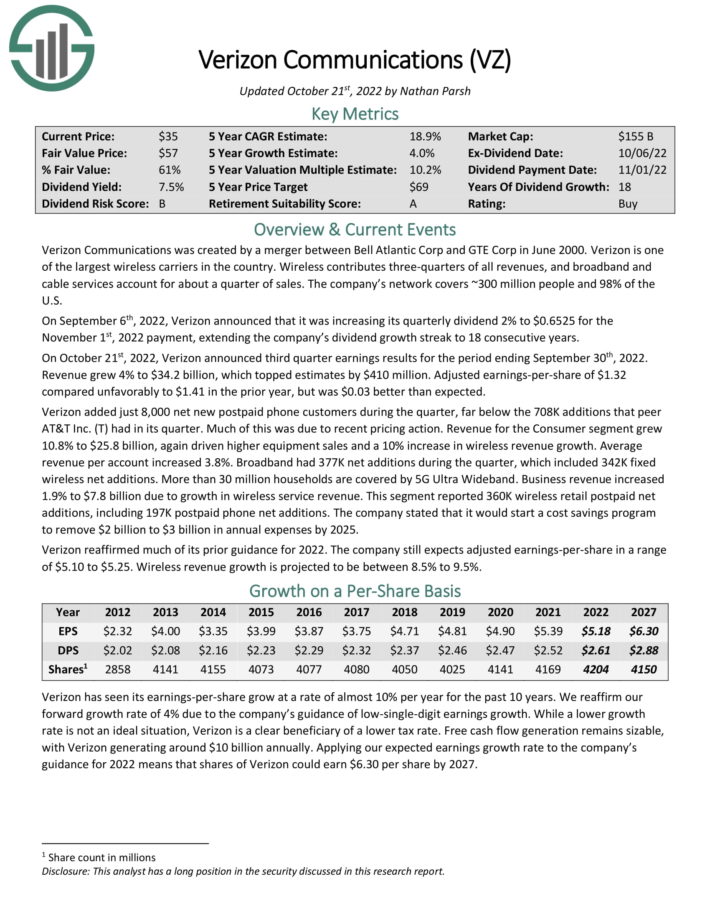
Final Thoughts
Investors must take risk into account when selecting from prospective investments. After all, if two securities are otherwise similar in terms of expected returns but one offers a much lower Beta, the investor would do well to select the low Beta security as they may offer better risk-adjusted returns.
Using Beta can help investors determine which securities will produce more volatility than the broader market and which ones may help diversify a portfolio, such as the ones listed here.
The five stocks we’ve looked at not only offer low Beta scores, but they also offer attractive dividend yields. Sifting through the immense number of stocks available for purchase to investors using criteria like these can help investors find the best stocks to suit their needs.
At Sure Dividend, we often advocate for investing in companies with a high probability of increasing their dividends each and every year.
If that strategy appeals to you, it may be useful to browse through the following databases of dividend growth stocks:
Thanks for reading this article. Please send any feedback, corrections, or questions to [email protected].
















